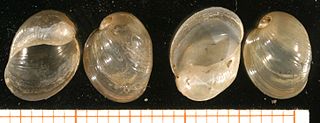
Astacus astacus, the European crayfish, noble crayfish, or broad-fingered crayfish, is the most common species of crayfish in Europe, and a traditional food source. Like other true crayfish, A. astacus is restricted to fresh water, living only in unpolluted streams, rivers, and lakes. It is found from France throughout Central Europe, to the Balkan Peninsula, and north as far as parts of the British Isles, Scandinavia and Finland, and Eastern Europe. Males may grow up to 16 cm long, and females up to 12 cm.
On 29 January 2010, the IUCN Red List of Threatened Species identified 5220 endangered species, subspecies and varieties, stocks and sub-populations.

Helix pomatia, common names the Roman snail, Burgundy snail, edible snail, or escargot, is a species of large, edible, air-breathing land snail, a pulmonate gastropod terrestrial mollusc in the family Helicidae. It is one of Europe's biggest species of land snail.
Version 2014.2 of the IUCN Red List of Threatened Species identified 4574 Critically Endangered species, subspecies and varieties, stocks and subpopulations.

A near-threatened species is a species which has been categorized as "Near Threatened" (NT) by the International Union for Conservation of Nature as that may be vulnerable to endangerment in the near future, although it does not currently qualify for the threatened status.

A data deficient (DD) species is one which has been categorized by the International Union for Conservation of Nature (IUCN) as offering insufficient information for a proper assessment of conservation status to be made. This does not necessarily indicate that the species has not been extensively studied; but it does indicate that little or no information is available on the abundance and distribution of the species.

Limax cinereoniger is a large species of air-breathing land slug in the terrestrial pulmonate gastropod mollusk family Limacidae, the keelback slugs. This is the largest land slug species in the world.

Pisidium pseudosphaerium is a species of freshwater bivalve from family Sphaeriidae.

Myxas glutinosa is a species of small air-breathing freshwater snail, an aquatic gastropod mollusc in the family Lymnaeidae, the pond snails.
Vallonia enniensis is a species of minute land snail, a terrestrial pulmonate gastropod mollusk or micromollusk in the family Valloniidae.

Acroloxus lacustris, or the lake limpet, is a small freshwater limpet or snail, a species of aquatic gastropod mollusk in the family Acroloxidae.

Ruthenica filograna is a species of air-breathing land snail, a terrestrial pulmonate gastropod mollusk in the family Clausiliidae, the door snails, all of which have a clausilium.
Chondrina clienta is a species of small air-breathing land snail, a terrestrial pulmonate gastropod mollusk in the family Chondrinidae.

Sphyradium doliolum is a species of air-breathing land snail, a terrestrial pulmonate gastropod mollusk in the family Orculidae.
On 29 January 2010, the IUCN Red List of Threatened Species identified 6,702 data deficient species.
This page is based on this
Wikipedia article Text is available under the
CC BY-SA 4.0 license; additional terms may apply.
Images, videos and audio are available under their respective licenses.









